

Map of Australia showing the location of Lady Elliot Island. Source: Ranger Rick Volume 28, No.9, P.45. Map by Jeffrey Hutman.
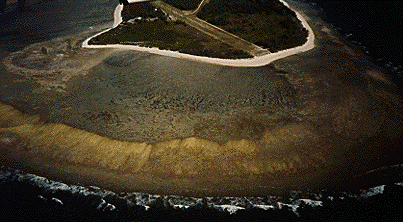
Lady Elliot Island is the only coral cay in the Great Barrier Reef with its own airstrip. The airstrip runs the entire diameter of the island (and gave our plane at least 20 meters leeway on landing). Lady Elliot is fringed on all sides by coral.
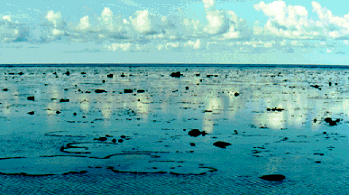
View of the lagoon and reef flat at Lady Elliot Island.
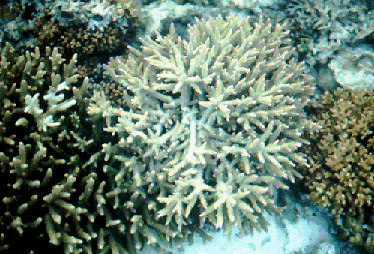
Three different species of branching coral compete for space in the reef flat. The corals' color comes from the symbiotic single-celled plants called zooxanthellae which lives within its tissue.
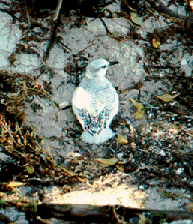
Phylum: Chordata Class: Aves Family: Phaethontidae Species: Phaethon rubricauda
At various times of year Lady Elliot Isaland is a breeding ground for green turtles and many birds, the endangered red-tailed tropic bird among them. Here an immature red-tailed tropic bird in its nest on the ground. Females usually produce a clutch of one egg (rarely two) which are incubated by both parents for about 40 days. Young are fed with fish from their parents' bills for a period of two to three months. Tropic birds are rare on Lady Elliot Island. One source indicates only a single pair nested in 1983 and 1984 and two pairs per year since then.
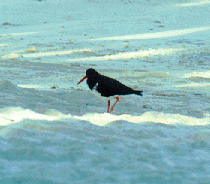
Phylum: Chordata Class: Aves Family: Haematopodidae Species: Haematopus longirostris
Both the pied (shown here) and the sooty oystercatchers were common on the shore at Lady Elliot.
Lady Elliot features a shallow inner reef extending out about 300 meters from the shoreline. At this point there is a narrow rubble crest of 30 meters or so and beyond that deeper water coral gardens and the Pacific. The shallow inner reef and easily accessible deeper water make Lady Elliot an ideal instructional laboratory.
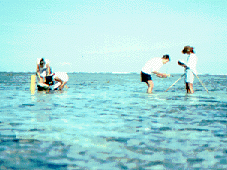
Students collecting data in the reef flat area on Lady Elliot Island.
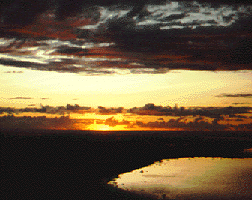
The sunsets over the reef flat were extraordinary.
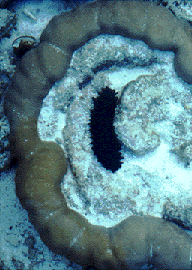
Phylum: Echinodermata Class: Holothuroidea Species: Holothuria leucospilota
One of the most common sights on the reef flat at Lady Elliot is the sea cucumber Holothuria leucospilota. In some areas, the reef can seem to be covered by these or other holothurians.
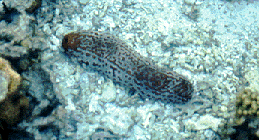
Phylum: Echinodermata Class: Holothuroidea Species: Bohadschia argus
A second type of sea cucumber, less common at Lady Elliot, is Bohadschia argus.
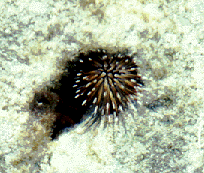
Phylum: Echinodermata Class: Echinoidea Species: Echinometra mathaei
This common sea urchin, Echinometra mathaei, has simple spines with white tips and is usually found in holes bored in coral. More information is available on Echinometra mathaei .
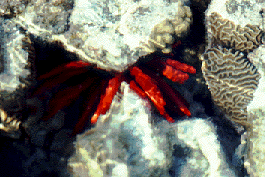
Phylum: Echinodermata Class: Echinoidea Species: Heterocentrotus mammillatus
Hiding in crevices, the spectacular Heterocentrotus mammillatus, or slate pencil urchin, with its many flattened spines was only occasionally seen in the reef flat. They may be up to 200 mm in diameter. More information is available on Heterocentrotus mammillatus .
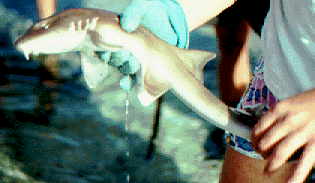
Phylum: Chordata Subphylum: Vertebrata Class: Elasmobranchii Order: Carchariniformes Species: Scyliorhinidae
Catsharks, Scyliorhinidae, form the largest family of sharks. They can be found in the inner reef area and are generally harmless.
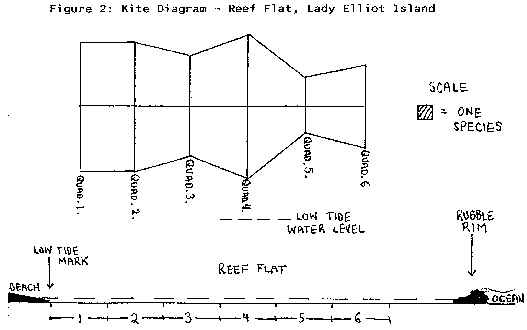
A kite diagram drawn by John Muhlfeld '95 shows species richness at various locations in the reef flat.
2. Day snorkel beyond the reef crest to orient students to the fauna of the outer reef, including black-tipped and white-tipped sharks, manta and eagle rays, green and loggerhead turtles, coral trout, sweetlips, tang, wrasse, parrot-fish, damsel-fish, butterfly-fish, angel-fish, flute- mouths, cleaner-fish, and moray eels.
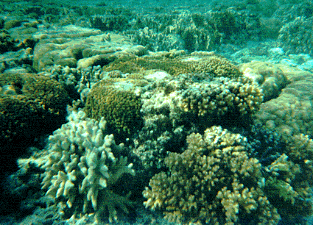
A favorite spot to snorkel beyond the reef crest was the "Coral Gardens." Here moray eels could be spotted and a little further out white-tipped and black-tipped sharks. Two students also spotted a hammerhead shark.
3. Night reefwalk and night snorkels to examine the very different (and eerie) nocturnal life of the reef.
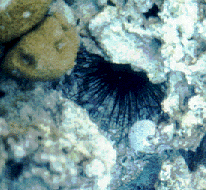
Phylum: Echinodermata Class: Echinoidea Species: Diadema savignyi
This particular urchin, Diadema savignyi, hides under rocks or coral during the day but is active at night and was seen during the night snorkeling. It has poisonous spines. More information is available on Diadema savignyi.
4. Day and night plankton sampling in the inner reef. These data were analyzed as part of the biodiversity course and formed part of a paper assignment on the biodiversity of Lady Elliot Island.
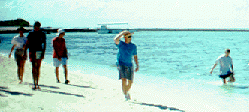
David Lowe '96 collects plankton in the inner reef area.
5. Comparison of marine life on top of inner reef rocks, under inner reef rocks, and on the sandy substrate in the inner reef. The colonial and encrusting nature of some marine flora and fauna highlighted the difficulties in collecting good data on "individuals" observed at a particular location. These data were compared with similar data collected on Stradbroke Island.
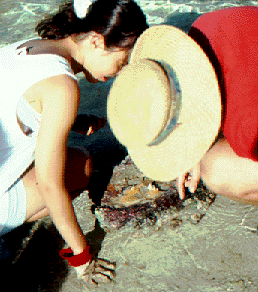
Dr. Ian Tibbetts and Amy Puccio '96 identify the organisms on the underside of a rock in the inner reef.
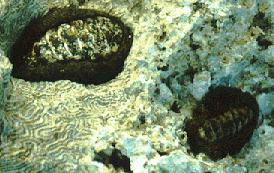
Phylum: Mollusca Class: Polyplacophora "Chiton"
Chitons are an ancient group of molluscs that usually graze on algae. In the Great Barrier Reef, they are often found in intertidal pools or under rocks at the shore's edge.
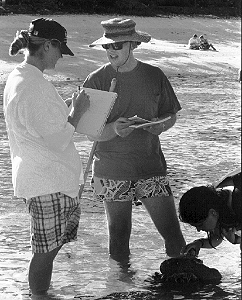
Dr. Ian Tibbetts and Jeanne Classen '96 discuss data collected in the inner reef.
6. Guest lecture by Dr. Ken Carle, Professor Emeritus of the Hobart and William Smith Colleges' Department of Chemistry, on the biochemistry of coral cay formation.
7. A guided walk around the island led by Ian Tibbetts tested students' ability to integrate material learned from lectures in Brisbane with field work.
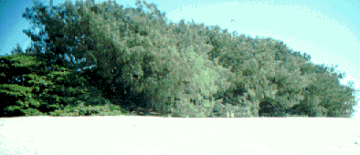
Typically there are three zones of vegetation on a small coral cay. The first and least fertile is the pioneer zone which abuts the beach front and is stabilized by plants such spinifex and bird's beak grass. The second zone (visible here) is dominated by small shrubs and trees such as the screw pine (Pandaneus tectorius) and the she-oak (Casuarina equisetfolia) whose nitrogen-fixing ability gives it a decided advantage. The third zone is dominated by Pisonia grandis, large soft-wood trees where the black noddies nest in dense groups.
8. Small group projects and oral reports on various topics chosen by students themselves. Among the topics for reports were: fish locomotion, distribution of starfish at various locations, the hydrology of Lady Elliot Island, waste treatment at Lady Elliot Island, and inter-species coral competition.
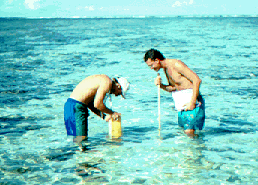
Chris Maciejeweski '95 and Rich Swallow '95 collect data for their project on giant clams.
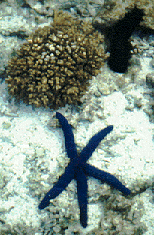
Phylum: Echinodermata Class: Asteroidea Species: Linckia laevigata
Among the most conspicuous invertebrates on the reef are the echinoderms (from the Greek for "spiny skin") such as the starfish (or sea stars) and the sea urchins. The most prominent of the starfish (asteroidea) are the bright blue Linckia laevigata which are quite common in the reef flat.
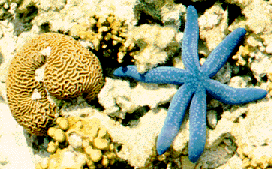
Phylum: Echinodermata Class: Asteroidea Species: Linckia laevigata
Most starfish have pentagonal symmetry. However, due to injury, one occasionally sees Linckia laevigata with either four or six arms.
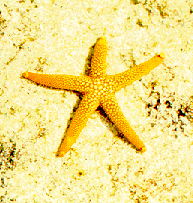
Phylum: Echinodermata Class: Asteroidea Species: Nardoa novacaledoniae
Somewhat less common, though by no means rare, are the mustard-yellow starfish Nardoa novacaledoniae which are also found in the reef flat.
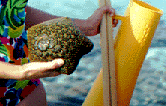
Phylum: Echinodermata Class: Asteroidea Species: Culcita novaguineae
The pincushion star is a common inhabitant of shallow patch, barrier, and fringing reefs. This individual was found in the inner reef flat at Lady Elliot.
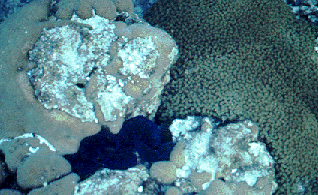
Two species of coral compete for space in the reef flat with a giant clam.
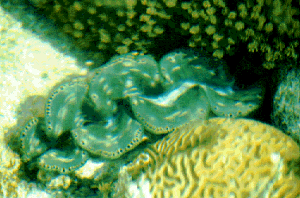
The lips of the mantle of the clam Tridacna crocea are brilliantly colored by the enclosed zooxanthellae with which it has a symbiotic relationship. The green and brown corals are also colored by their symbiotic zooxanthellae.